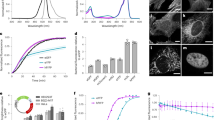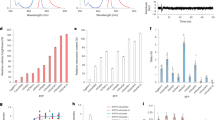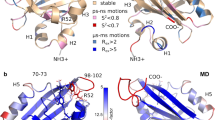Abstract
The crystal structure of recombinant wild-type green fluorescent protein (GFP) has been solved to a resolution of 1.9 Å by multiwavelength anomalous dispersion phasing methods. The protein is in the shape of a cylinder, comprising 11 strands of ß-sheet with an α-helix inside and short helical segments on the ends of the cylinder. This motif, with ß-structure on the outside and α-helix on the inside, represents a new protein fold, which we have named the ß-can. Two protomers pack closely together to form a dimer in the crystal. The fluorophores are protected inside the cylinders, and their structures are consistent with the formation of aromatic systems made up of Tyr86 with reduction of its Cα-Cß bond coupled with cyclization of the neighboring glycine and serine residues. The environment inside the cylinder explains the effects of many existing mutants of GFP and suggests specific side chains that could be modified to change the spectral properties of GFP. Furthermore, the identification of the dimer contacts may allow mutagenic control of the state of assembly of the protein.
This is a preview of subscription content, access via your institution
Access options
Subscribe to this journal
Receive 12 print issues and online access
$209.00 per year
only $17.42 per issue
Buy this article
- Purchase on Springer Link
- Instant access to full article PDF
Prices may be subject to local taxes which are calculated during checkout
Similar content being viewed by others
References
Morin, J. and Hastings, J. 1971. Energy transfer in a bioluminescent system. J. Cell Physiol. 77: 313–318.
Ward, W. 1979 pp. 1–57 in Photochemical and photobiological reviews. K. Smith (ed.). Plenum Press, New York.
Prasher, D., Eckenrode, V., Ward, W., Prendergast, F., and Cormier, M. 1992. Primarystructure of the Aequorea victoria green fluorescent protein. Gene 111: 229–233.
Chalfie, M., Tu, Y., Euskirchen, G., Ward, W., and Prasher, D. 1994 Green fluorescent protein as a marker for gene expression. Science 263: 802–805.
Kahana, J., Schapp, B., and Silver, P. 1995. Kinetics of spindle pole body sepa ration in budding yeast Proc. Natl. Acad. Sci. USA 92: 9707–9711.
Moores, S., Sabry, J., and Spudich, J. 1996. Myosin dynamics in live Dictyostelium cells. Proc. Natl. Acad. Sci. USA 93: 443–446.
Casper, S. and Holt, C. 1996. Expression of the green fluorescent protein-encoding gene from a tobacco mosaic virus-based vector. Gene 173: 69–7.
Epel, B., Padgett, H., Heinlein, M., and Beachy, R. 1996. Plant virus movement protein dynamics probed with a GFP-protein fusion. Gene 173: 75–79
Wang, S. and Hazelrigg, T. 1994. Implications for bed mRNA localization from spatial distribution of exu protein in Drosophila oogenesis. Nature 369: 400–403.
Amsterdam, A., Lin, S., Moss, L., and Hopkins, N. 1996. Requirements for green fluorescent protein detection in transgenic zebrafish embryos. Gene 173: 99–103.
Ludin, B., Doll, T., Meill, R., Kaech, S., and Matus, A. 1996. Application of novel vectors for GFP-tagging of proteins to study microtubule-associated proteins. Gene 173: 107–111.
DeGiorgi, F., Brini, M., Bastianutto, C., Marsault, R., Monteto, M. Pezo, P. et al. 1996. Targeting aequorin and green fluorescent protein to intracelular oganelles. Gene 173: 113–117.
Cubitt, A., Heim, R., Adams, S., Boyd, A., Gross, L., and Tsien R. 1995. Understanding, improving and using green fluorescent proteins. TIBS 2: 448–455.
Olsen, K., Mclntosh, J., and Olmstead, J. 1995. Analysis of MAP4 function in living cells using green fluorescent protein (GFP) chimeras. J. Cell Biol. 13O: 639–650.
Rizzuto, R., Brini, M., De Giorgi, F., Rossi, R., Heim, R. Tsien R. et al. 1996. Double labeling of subcellular structures with organelle-targeted GFP mutants in vivo. Curr. Biol. 6: 183–188.
Kaether, C. and Gerdes, H. 1995. Visualization of protein transport along the secretory pathway using green fluorescent protein. FEBS Lett. 369: 267–271.
Marshall, J., Molloy, R., Moss, G., Howe, J., and Hughes, T. 1995. The jellyfish green fluorescent protein a new tool for studying ion channel expression and function. Neuron 14: 211–215.
Mitra, R., Silva, C., and Youvan D. 1996. Fluorescence resonance energy trans fer between blue-emitting and red-shifted excitation derivatives of the green fluorescent protein. Gene 173: 13–7.
Kahana, J. and Silver, P. 1996. pp 9. 7. 22-9.7-28 in Current protocols in molecular biology. Ausabel F., et al. (eds.). Green and Wiley, New York.
Cody, C.W., Prasher, D.C., Westler, W.M., Prendergast, F.G. and Ward W.W. 1993. Chemical structure of the hexapeptide chromophore of the Aequorea green-fluorescent protein. Biochemistry 32: 1212–1218.
Heim, R., Prasher, D.C., and Tsien, R.Y. 1994. Wavelength mutations and post translational autoxidation of green fluorescent protein. Proc. Natl. Acad. Sci. USA 91: 12501–12504.
Delagrave, S., Hawtin, R., Silva, C., Yang, M., and Youvan, D. 1995. Red-shifted excitation mutants of the green fluorescent protein. Bio/Technology 13: 151–154.
Lim, C., Kimata, K., Oka, M., Nomaguchi, K., and Kohno, K., 1995. Thermo-sensitivrty of a green fluorescent protein utilized to reveal novel nuclear like com partments. J. Biochem. (Tokyo) 118: 13–17.
Ward W.W. and Bokman, S.H. 1982. Reversible denaturation of Aequorea green-fluorescent protein physical separation and characterization of the renatured protein. Biochemistry 21: 4535–4540.
Ward, W., Prentice H., Roth, A. Cody, C. and Reeves S. 1982. Spectral perturbations of the Aequona green fluorescent protein. Photochem. Photobiol. 35: 803–808.
Inouye, S. and Tsuji, F.I 1994 Evidence for redox forms of the Aequorea green fluorescent protein. FEBS Lett. 351: 211–214.
Dopf, J. and Horiagan, T. 1996. Deletion mapping of the Aequoria victoria green fluorescent protein. Gene 173: 39–44.
Heim, R., Cubitt A. and Tsien, R. 1995. Improved green fluorescence. Nature 373: 663–664.
Cormack B., Valdivia, R., and Falkow, S. 1996 FACS optimized mutants of the green fluorescent protein (GFP). Gene 173: 33–38.
Ehng, T., O'Kane, D., and Prendergast F. 1995. Green-fluorescent protein mutants with altered fluorescence excitation spectra. FEBS Lett 367: 163–166
Crameri A., Whrtehom E., Tate, E., and Stemmer, W. 1996. Improved green fluorescent protein by molecular evolution using DMA shuffling. Nature Biotech. 14: 315–319.
Perozzo, M., Ward, K., Thompson, R., and Ward, W. 1988. X-ray diffraction and time resolved fluorescence analyses of Aequorea green fluorescent protein crystals. J. Biol. Chem. 263: 7713–7716.
Merbs S. and Nathans, J. 1992 Absorption spectra of the hybrid pigments responsible for anomalous color vision. Science 258: 464–466.
Rao, B., Kemple, M., and Prendergast, F. 1980. Proton nuclear magnetic resonance and fluorescence spectroscopic studies of segmental mobility in aequorin and a green fluorescent protein from Aequorea forskalea. Biophys. J. 32: 630–632.
Ormö, M., Cubitt, A., Kallio, K., Gross, L., Tsien, R., and Remington, S. 1996. Crystal structure of the Aequorea victona green fluorescent protein. Science In press.
Wright, H. 1991. Nonenzymatic deamidation of asparaginyl and glutaminyl residues in proteins. Crit. Rev. Biochem. Mol. Biol.. 26: 1–52.
Chattoraj, M., King, B., Bublitz, G., and Boxer S. 1996. Ultra-fast excited state dynamics in green fluorescent protein Multiple states and proton transfer Proc. Natl. Acad. Sci. USA. 93: 8362–8367.
Otwinowski, Z. 1993. Data collection and processing in Proceedings of the CCP4 study weekend. Warnngton, England Daresbury Laboratory.
Sheldrick, G., Dauter, Z., Wilson, K., Hope, H., and Sieker, L. 1993. The applica tion of direct methods and Patterson interpretation to high-resolution native protein data. Acta Cryst. D49: 18–23.
Terwilliger, T., Kim, S.-H., and Eisenberg, D. 1987. Generalized method of determining heavy-atom positions using the difference Patterson function. Acta Cryst. A43: 1–5.
Yang, W., Hendrickson, W., Crouch R. and Satow Y. 1990. Structure of ribonuclease H phased at 2 A by MAD analysis of the selemomethionyl protein. Science 249: 1398–1405.
Collaborative Computational Project, N 1994. The CCP4 suite Programs for pro tem crystallography. Acta Crysf D50: 760–763.
Jones, T., Zou, J., Cowan, S. and Kjeldgaard M. 1991. Improved methods for building protein models in electron density maps and the location of errors in these models. Acta Crystallogr. 47: 110–119.
Brunger, A. 1992. X-PLOR Version 31 A system for X ray crystallography and NMR. Yale University Press, New Haven CT
Carson, M. 1987. Ribbon models of macromolecules. J. Mol. Graphics 5: 103–106.
Sayle, R. and Milner-White, E. 1995. RasMol Biomolecular graphics for all. TIBS 20: 374–375.
Author information
Authors and Affiliations
Rights and permissions
About this article
Cite this article
Yang, F., Moss, L. & Phillips, G. The molecular structure of green fluorescent protein. Nat Biotechnol 14, 1246–1251 (1996). https://doi.org/10.1038/nbt1096-1246
Received:
Accepted:
Issue Date:
DOI: https://doi.org/10.1038/nbt1096-1246
This article is cited by
-
Photoautotrophic potential and photosynthetic competence in Ananas comosus [L]. Merr. cultivar Turiaçu in in vitro culture systems
In Vitro Cellular & Developmental Biology - Plant (2024)
-
A monomeric StayGold fluorescent protein
Nature Biotechnology (2023)
-
piggyBac-mediated genomic integration of linear dsDNA-based library for deep mutational scanning in mammalian cells
Cellular and Molecular Life Sciences (2023)
-
A deep-learning system bridging molecule structure and biomedical text with comprehension comparable to human professionals
Nature Communications (2022)
-
Potent inhibitors of toxic alpha-synuclein identified via cellular time-resolved FRET biosensors
npj Parkinson's Disease (2021)



